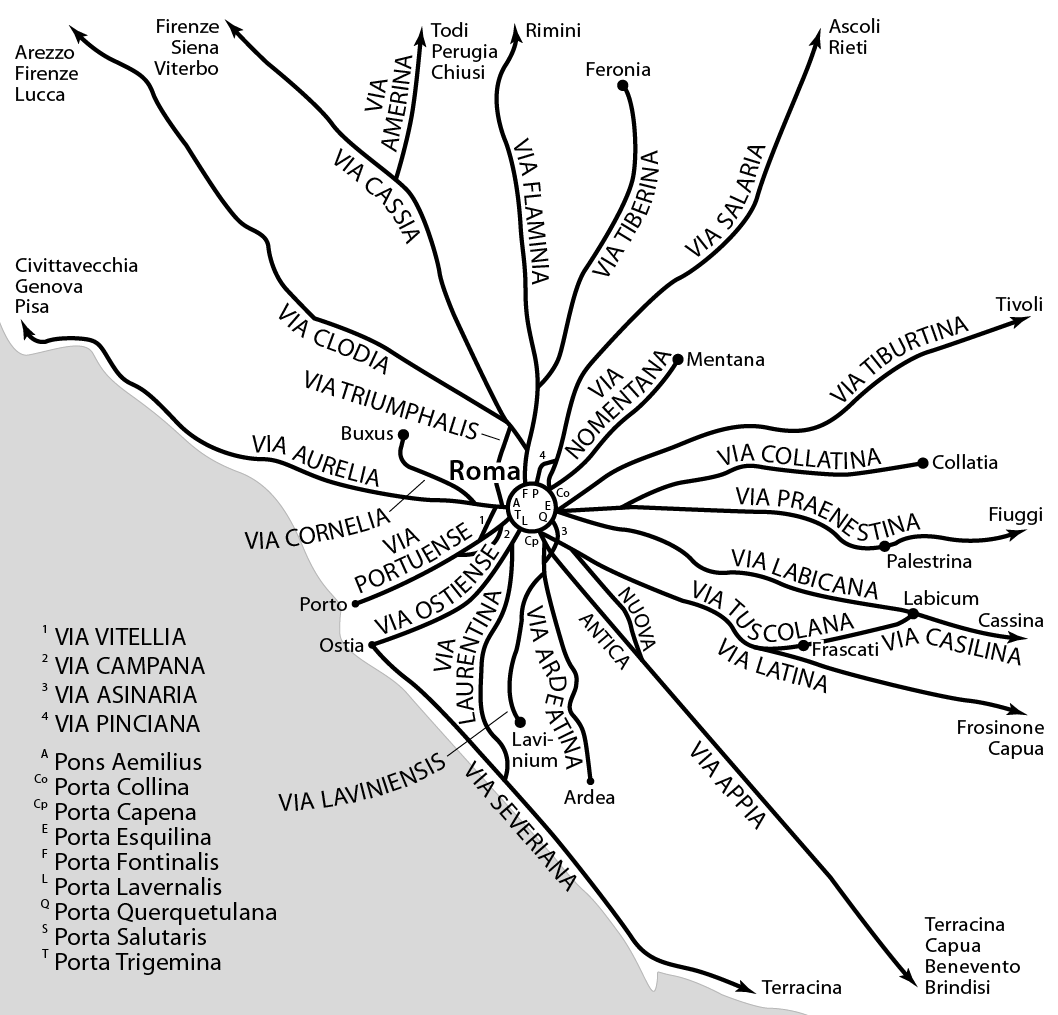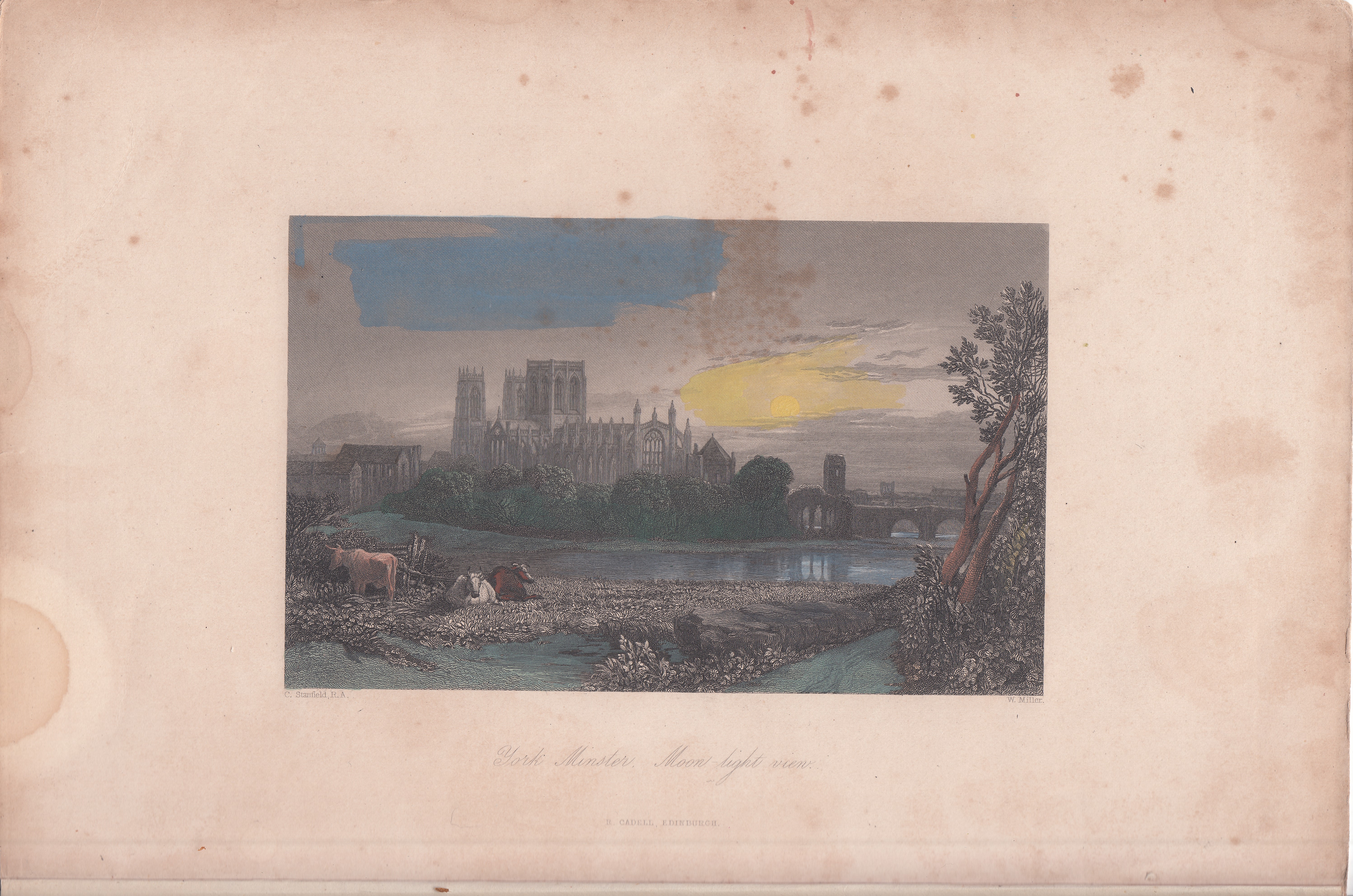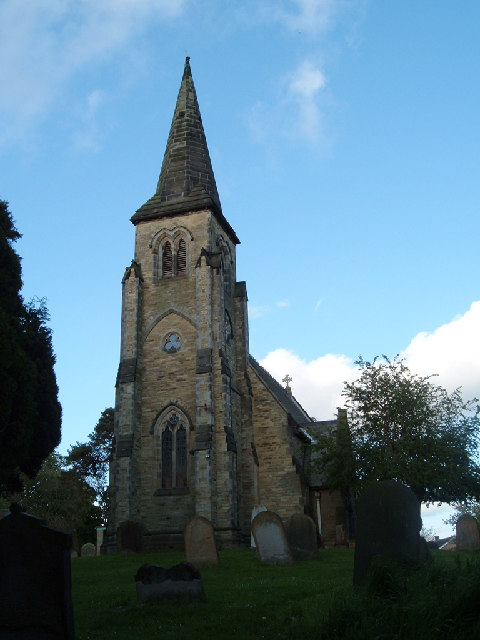|
Ebor Way
The Ebor Way is a 70-mile (112 km) long-distance footpath from Helmsley, North Yorkshire to Ilkley, West Yorkshire, via the city of York, England. It takes its name from Eboracum, the Roman name for York. This walk connects the Cleveland Way and Dales Way running across the Howardian Hills, through the low-lying vale of York and then up the Wharfe valley. It was first developed in the 1970s by the Ebor Acorn Rambling Club. From Helmsley, the walk heads south via Oswaldkirk, Cawton and Hovingham to Terrington. Here it is joined by the Centenary Way, which follows a broadly similar route to York, although the two diverge at times. From Terrington, it continues south to Sheriff Hutton and Strensall, then runs alongside the River Foss to the centre of York. Passing York Minster, it skirts round the north and west sides of the city walls before leaving the city on the west bank of the River Ouse. Turning west away from the river, the path goes through the satellite villa ... [...More Info...] [...Related Items...] OR: [Wikipedia] [Google] [Baidu] |
Eccup
Eccup is a village in the parish of Alwoodley and north of the City of Leeds, West Yorkshire, England. It is just north of Alwoodley and east of Bramhope and Golden Acre Park. Eccup is at the north-west edge of Eccup Reservoir. On 1 April 1926 Eccup became a civil parish, being formed from part of Adel cum Eccup, on 1 April 1928 the parish was abolished and merged with Leeds. Etymology The place-name ''Eccup'' is first attested in the Domesday Book of 1086 as ''Echope''. It is thought to derive from an Old English personal name ''Ecca'' + ''hōp'' 'enclosed land amid unpromising land; a small, enclosed valley'. It would therefore mean something like 'Ecca's patch of good land'. The name is referred to as ''Ecop'' in the Coucher Book of Kirkstall Abbey. From the sixteenth century the area up to the River Wharfe was known as ''Adel cum Eccup''. [...More Info...] [...Related Items...] OR: [Wikipedia] [Google] [Baidu] |
Cawton
Cawton is a village and civil parish in North Yorkshire, England, about ten miles west of Malton. According to the 2001 census it had a population of 48. It is due east of Gilling East (where the 2011 Census figures are included), and south-east of Oswaldkirk. It is on the path of the Ebor Way. From 1974 to 2023 it was part of the district of Ryedale, it is now administered by the unitary North Yorkshire Council North Yorkshire Council, known between 1974 and 2023 as North Yorkshire County Council, is the local authority for the non-metropolitan county of North Yorkshire, England. Since 2023 the council has been a unitary authority, being a county coun .... See also * Listed buildings in Cawton Referencesvisionofbritain.org.uk, ''Cawton, North Riding''. External links Villages in North Yorkshire Civil parishes in North Yorkshire {{NorthYorkshire-geo-stub ... [...More Info...] [...Related Items...] OR: [Wikipedia] [Google] [Baidu] |
Harewood, West Yorkshire
Harewood ( ) is a village, civil parishes in England, civil parish, former Manorialism, manor and ecclesiastical parish, in West Yorkshire, England, today in the metropolitan borough of the City of Leeds. The civil parish population at the 2011 census was 3,734. Etymology The name of Harewood is first attested in the tenth-century Rushworth Gospels manuscript, in the form ''æt Harawuda'' ('at Harewood'); it is next attested in the Domesday Book of 1086, as ''Hareuuode''. Although consideration has been given to an origin involving the Old English word ''hār'' ('grey'), commentators agree that, as the name's present-day form suggests, the name comes from the Old English words ''hara'' ('hare') and ''wudu'' ('wood'). Thus it once meant 'wood characterised by hares'. Location Harewood sits in the Harewood (ward), Harewood electoral ward, ward of Leeds City Council and Elmet and Rothwell (UK Parliament constituency), Elmet and Rothwell parliamentary constituency. The A61 road, A ... [...More Info...] [...Related Items...] OR: [Wikipedia] [Google] [Baidu] |
Boston Spa
Boston Spa is a village and civil parish in the Leeds Metropolitan District in West Yorkshire West Yorkshire is a Metropolitan counties of England, metropolitan and Ceremonial counties of England, ceremonial county in the Yorkshire and the Humber region of England. It borders North Yorkshire to the north and east, South Yorkshire and De ..., England. Situated south of Wetherby, Boston Spa is on the south bank of the River Wharfe across from Thorp Arch, West Yorkshire, Thorp Arch. According to the 2001 census, the parish had a population of 4,006 rising to 4,079 in the 2011 census. It sits in the Wetherby (ward), Wetherby ward of Leeds City Council and the Wetherby and Easingwold (UK Parliament constituency), Wetherby and Easingwold UK Parliament constituencies, parliamentary constituency. Etymology Boston Spa's name is not attested before appearing on printed maps in 1771, when it was labelled ''Thorp Spaw'', presumably 'the spa associated with Thorp Arch' (the nearest s ... [...More Info...] [...Related Items...] OR: [Wikipedia] [Google] [Baidu] |
Tadcaster
Tadcaster is a market town and civil parishes in England, civil parish in North Yorkshire, England, north-east of Leeds and south-west of York. Its historical importance from Roman times onward was largely as the lowest road crossing-point on the River Wharfe until the construction of the A64 Tadcaster by-pass some to the south, in 1978. There are two rail crossings downstream of the town before the Wharfe joins the River Ouse, Yorkshire, River Ouse near Cawood. Thanks to its position on the banks of the River Wharfe parts of the town adjacent to the bridge are prone to flooding. The town was part of the West Riding of Yorkshire until 1974, but is now part of North Yorkshire. Tadcaster is town twinning, twinned with Saint-Chély-d'Apcher in France. History Roman The Roman Britain, Romans built a settlement and named it ''Calcaria'' from the Latin word for ''lime'', reflecting the importance of the area's limestone geology as a natural resource for quarrying, an industry ... [...More Info...] [...Related Items...] OR: [Wikipedia] [Google] [Baidu] |
Calcaria
Calcaria was a town in the Roman province of Britannia. Today, it is known as Tadcaster, located in the English county of North Yorkshire. The Romans founded the settlement and named it ''Calcaria'' from the Latin word for ''lime kilns'', reflecting the importance of the area's Magnesian Limestone geology as a natural resource for quarrying. The nature of the settlement is uncertain. It is possible that it started as an Imperial staging post with a mansio because of its location at a river crossing on the road from Danum (Doncaster) to Eburacum (York). Just to the north-west is the Roman fort ''Castra'' () is a Latin term used during the Roman Republic and Roman Empire for a military 'camp', and ''castrum'' () for a 'fort'. Either could refer to a building or plot of land, used as a fortified military base.. Included is a discuss ... at Newton Kyme (possibly Praesidium) dating from the 4th century. Mileages on the Antonine Itinerary suggest that Calcaria may have ... [...More Info...] [...Related Items...] OR: [Wikipedia] [Google] [Baidu] |
Roman Road
Roman roads ( ; singular: ; meaning "Roman way") were physical infrastructure vital to the maintenance and development of the Roman state, built from about 300 BC through the expansion and consolidation of the Roman Republic and the Roman Empire. They provided efficient means for the overland movement of armies, officials, civilians, inland carriage of official communications, and trade goods. Roman roads were of several kinds, ranging from small local roads to broad, long-distance highways built to connect cities, major towns and military bases. These major roads were often stone-paved and metaled, cambered for drainage, and were flanked by footpaths, bridleways and drainage ditches. They were laid along accurately surveyed courses, and some were cut through hills or conducted over rivers and ravines on bridgework. Sections could be supported over marshy ground on rafted or piled foundations.Corbishley, Mike: "The Roman World", page 50. Warwick Press, 1986. At the peak of ... [...More Info...] [...Related Items...] OR: [Wikipedia] [Google] [Baidu] |
Copmanthorpe
Copmanthorpe () is a village and civil parishes in England, civil parish in the City of York in the English county of North Yorkshire, south-west of York, west of Bishopthorpe and close to Acaster Malbis, Askham Bryan and Askham Richard. According to the 2001 census the parish had a population of 4,262, reducing to 4,173 at the 2011 Census. The village was historically part of the West Riding of Yorkshire until 1974. It was then a part of the district of Selby District in North Yorkshire from 1974 until 1996. Since 1996 it has been part of the City of York unitary authority. The village is part of the York Outer (UK Parliament constituency), York Outer constituency. The village is mentioned in the Domesday Book of 1086 as ''Copemantorp'', from Old Norse ''Kaupmanna þorp'', meaning ''Traders' Village'' or ''Craftsmen's Village''. The area of Copmanthorpe covering Main Street, Church Street and Low Green became a Conservation Area in 1978. Copmanthorpe is bounded to the north b ... [...More Info...] [...Related Items...] OR: [Wikipedia] [Google] [Baidu] |
Bishopthorpe
Bishopthorpe is a village and civil parish three miles south of York in the City of York Unitary authorities of England, unitary authority area and ceremonial counties of England, ceremonial county of North Yorkshire, England. Bishopthorpe is close to the River Ouse, Yorkshire, River Ouse, and has a population of 3,174, increasing to 3,237 at the 2011 Census. The area of Main Street and the Palace were made a conservation area in 1989 along with other open areas of the village. The village was historically part of the West Riding of Yorkshire until 1974. It was then a part of the district of Selby District in North Yorkshire from 1974 until 1996. Since 1996 it has been part of the City of York unitary authority. It was formerly known as St Andrewthorpe, but in the 13th century, Archbishop Walter de Grey bought the manor house and gave it to the Dean and Chapter of York Minster. This became Bishopthorpe Palace, the residence of the Archbishop of York. Many of the roads in Bisho ... [...More Info...] [...Related Items...] OR: [Wikipedia] [Google] [Baidu] |
York Minster
York Minster, formally the Cathedral and Metropolitical Church of Saint Peter in York, is an Anglicanism, Anglican cathedral in the city of York, North Yorkshire, England. The minster is the seat of the archbishop of York, the second-highest office of the Church of England, and is the Mother Church#Cathedral, mother church for the diocese of York and the province of York.It is administered by its Dean of York, dean and Chapter (religion), chapter. The minster is a Grade I listed building and a scheduled monument. The first record of a church on the site dates to 627; the title "Minster (church), minster" also dates to the Anglo-Saxon period, originally denoting a missionary teaching church and now an honorific. The minster undercroft contains re-used fabric of , but the bulk of the building was constructed between 1220 and 1472. It consists of Early English Period, Early English Gothic north and south transepts, a Decorated Gothic, Decorated Gothic nave and chapter house, and a ... [...More Info...] [...Related Items...] OR: [Wikipedia] [Google] [Baidu] |
Strensall
Strensall is a village in the Strensall with Towthorpe civil parish in the unitary authority of the City of York in North Yorkshire, England, on the River Foss north of York and north-east of Haxby. In 2001 the parish had a population of 3,815. It covers an area of 2,908 acres. The village was historically part of the North Riding of Yorkshire until 1974. It was then a part of the district of Ryedale in North Yorkshire from 1974 until 1996. Since 1996 it has been part of the City of York unitary authority. On 1 April 2009 the parish was abolished and merged with Towthorpe to form "Strensall with Towthorpe". The nearby Strensall Common is a Special Area of Conservation, an example of lowland heathland habitat covering over 5 km2. The southern part is designated as a Site of Special Scientific Interest. Strensall also has an army firing range and training area both of which belong to the Ministry of Defence. History Strensall is referred to in the Domesday Book of 1086 ... [...More Info...] [...Related Items...] OR: [Wikipedia] [Google] [Baidu] |
Sheriff Hutton
Sheriff Hutton is a village and civil parish in North Yorkshire, England. It lies about north by north-east of York. History The village is mentioned twice in the Domesday Book of 1086, as ''Hotun'' in the Bulford hundred. Before the Norman invasion the manor was split between several land owners. Those named included ''Ligulf'', ''Northmann'', ''Thorkil'', ''Thorsten'' and ''Thorulf''. Afterwards some of the land was retained by the Crown and other portions given to Count Robert of Mortain who installed Nigel Fossard as lord of the manor. Soon after this, the land was in the possession of the Bulmer family. Bertram de Bulmer built the first castle in the village during the reign of King Stephen. After the civil war between Stephen and Matilda, the castle and manor were seized by the Crown before being held for the king by the Mauley family. The manor eventually came into the possession of the Neville family in the 14th century until 1480, when it was surrendered to the Cr ... [...More Info...] [...Related Items...] OR: [Wikipedia] [Google] [Baidu] |











